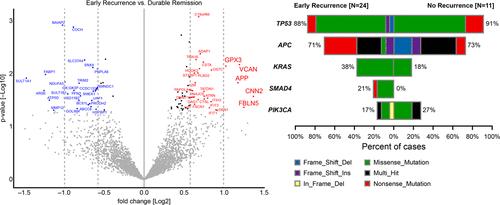Proteogenomic Characterization of Early Intrahepatic Recurrence after Curative-Intent Treatment of Colorectal Liver Metastases
IF 4.3
3区 材料科学
Q1 ENGINEERING, ELECTRICAL & ELECTRONIC
引用次数: 0
Abstract
Clinical and pathological factors are insufficient to accurately identify patients at risk of early recurrence after curative-intent treatment of colorectal liver metastases (CRLM). This study aimed to identify candidate prognostic proteogenomic biomarkers for early intrahepatic recurrence after curative-intent resection of CRLM. Patients diagnosed with intrahepatic recurrence within 6 months of liver resection were categorized as the “early recurrence” group, while those who achieved a recurrence-free status for 10 years were designated as “durable remission”. Comprehensive genomic and proteomic profiling of fresh frozen samples from these prognostically distinct groups was performed using the TruSight Oncology 500 assay and label-free data-dependent acquisition liquid chromatography–mass spectrometry. Genetic alterations were identified in 117 of the 523 profiled genes in patients with early recurrence. The most common somatic mutations linked to early recurrence were TP53 (88%), APC (71%), KRAS (38%), and SMAD4 (21%). SMAD4 alterations were absent in samples from patients with a durable remission. Calponin-2, versican core protein, glutathione peroxidase 3, fibulin-5, and amyloid-β precursor protein were upregulated more than 2-fold in early recurrence. Exploratory analysis of these proteogenomic biomarkers suggests that SMAD4, calponin-2, and glutathione peroxidase 3 may have the potential to predict early recurrence, enabling improved prognostication and precision oncology in CRLM.

结直肠癌肝转移治愈性治疗后早期肝内复发的蛋白质基因组特征描述
临床和病理因素不足以准确识别结直肠肝转移(CRLM)治愈性治疗后有早期复发风险的患者。本研究旨在确定结直肠肝转移瘤根治性切除术后早期肝内复发的候选预后蛋白基因组生物标志物。肝脏切除术后6个月内确诊肝内复发的患者被归为 "早期复发 "组,而10年内无复发的患者被归为 "持久缓解 "组。利用 TruSight Oncology 500 检测法和无标记数据依赖采集液相色谱-质谱联用技术,对这些不同预后组的新鲜冷冻样本进行了全面的基因组和蛋白质组分析。在早期复发患者的 523 个分析基因中,有 117 个基因发生了基因改变。与早期复发相关的最常见体细胞突变是TP53(88%)、APC(71%)、KRAS(38%)和SMAD4(21%)。持久缓解患者的样本中不存在 SMAD4 变异。在早期复发患者中,钙蛋白-2、versican 核心蛋白、谷胱甘肽过氧化物酶 3、纤维蛋白-5 和淀粉样蛋白-β 前体蛋白上调超过 2 倍。对这些蛋白质基因组生物标志物的探索性分析表明,SMAD4、钙蛋白-2和谷胱甘肽过氧化物酶3可能具有预测早期复发的潜力,从而改善CRLM的预后和精准肿瘤学。
本文章由计算机程序翻译,如有差异,请以英文原文为准。
求助全文
约1分钟内获得全文
求助全文

 求助内容:
求助内容: 应助结果提醒方式:
应助结果提醒方式:


